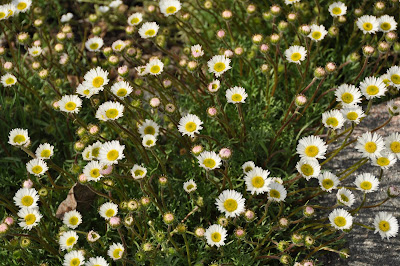The raised beds inside the rock walls are looking more green every day.
Though full of perennials, they look so bare until late May, when the
earth comes alive with plants that the winter had driven underground. There are innumerable trucks towing boats rumbling down the road to the boat launch at Nut Point Provincial park. They get to see me digging dandelions out of the flower beds, and the occasional slow-driving sightseer seems to appreciate the effort.
Last night, I put four bags of "Natural Cedar Mulch" into this flowerbed adjacent the driveway. I had a bit of mulch here before, but nearly the entire bed is mulched now. Not only does this smell wonderful, but I find the mulched areas have minimal weeds and require less water. Of course, it looks great too. Cedar mulch contains oils that repel bugs and it is one of the longest lasting mulches, breaking down a lot slower than the other types of wood mulches. There was also mulch available in black and a tandoori-red, apparently dyed in these colors for people that need their mulch to look more vibrant or whatnot. I don't really care for the dyed ones, though I can't find that they are harmful. One website even offers a spray-on dye to renew the color that your mulch came in. That just seems dumb.
 |
| Newly mulched flower bed. |
 |
| Grape hyacinths in the raised bed. These are a great little naturalizing (multiply freely) bulb. |
 |
| The large raised bed. The foreground highbush cranberries (Viburnum trilobum) have not leafed out yet. |
|
|
 |
| Alpine garden with all its white spring blooms. |
The alpine garden is bright with the masses of spring blooms, including
Erigeron compositus, Cerastium alpinum, and Dryas octopetala. Of these, Cerastium and Erigeron spread rapidly, and I occasionally pull bunches of them just to maintain the aesthetic. Dryas is nicely behaved and slowly creeps over adjacent rocks. Erigeron seems to spread by seed and is easy to pull, so I don't mind it much.
 |
| Dryas octopetala, a nice evergreen creeping groundcover flower in the alpine garden. |
 |
| Phlox subulata "Herbert" is said to be one of the lowest creeping phloxes available. It certainly is an attractive little specimen. Even the flowers are miniature. |
 |
| Erigeron compositus, a generously spreading plant that I have let have run free in the alpine bed. Sometimes you have to let something take over just so that the weeds don't have any available room. |










1 comment:
The petite Phlox subulata is very sweet, and quite full of blooms for such a small plant. I like the way your raised bed makes it easy to see the little alpines. Your beautiful stone beds are actually a great setting for all of the plants. Grape hyacinths great for mixing in between other spring plants. I wouldn't mind if mine spread a little more.
Post a Comment